#WASP-96b
Text
Now that the world’s most powerful space telescope is finally up and running, we’re in for a constant stream of stunning images of the universe. Just a ton of galaxies everywhere, more detailed than you’ve ever seen them, and too many stars to count—all of it sparkling with an intensity that humankind hasn’t captured before.
Not every interesting image from the James Webb Space Telescope is going to be a pretty picture, though. Some will be charts, like the one that NASA unveiled last week, all lines and dots and squiggles. That chart doesn’t have the special oomph of Webb’s view of galaxy clusters, or the wow factor of the Carina Nebula snapshot. But the unassuming chart, and the many others like it that Webb will produce over the next 20 years, is quietly thrilling in its own way. These images will stretch our imagination about what the worlds that exist far beyond our solar system are like.
You do have to know what you’re looking at, first. The chart reveals detailed information about the atmosphere of a giant, gaseous exoplanet with Jupiterlike qualities. WASP-96b resides about 1,150 light-years from us, tracing a loop around its own sun in just 3.5 Earth days. Its temperatures are higher than 1,000 degrees Fahrenheit (about 538 degrees Celsius). By measuring starlight that passed through the exoplanet’s atmosphere, Webb was able to detect the unmistakable signature of water, and even found evidence of clouds. On a planet as scorching as this one, clouds are really something else. It’s so hot that rock can condense in the air the way that water does here on Earth. Which means that on WASP-96b, the clouds are made of sand.
Sand! When Nikole Lewis, an astrophysicist at Cornell, told me this, I nearly fell out of my chair. “There are lots of things that will condense, other than water, given the right pressure and temperature conditions,” Lewis explained, as if she hadn’t just upended my idea of something as seemingly simple as clouds. I looked out my window, at the clouds of this planet, fluffy white poofs hovering in a blue sky, and Earth suddenly felt like exactly what it was, one of many, many planets in the universe, each with its own story and potentially its own kind of atmosphere. This is what Webb is poised to do: transform exoplanets in our mind from unknowable cosmic objects to very real places with alien skies.
Astronomers so far have discovered more than 5,000 of these exoplanets using other space telescopes and ground-based observatories. They’re quite skilled at discerning, upon discovery, an exoplanet’s orbit, mass, density, and other fundamental properties. And they’re getting better at teasing out information about their atmospheres. The Webb mission will send that particular effort into overdrive, revealing hidden details in targets that astronomers have already studied, uncovering the unknowns of worlds that they couldn’t reach before, and detecting, perhaps, the molecules that we know to be associated with the presence of life.
Webb observes exoplanet atmosphere this way: The space telescope aims its gaze at a star system and waits, basking in the incoming light. When a planet comes into view, moving—from our perspective—across the face of the star, the world blocks a little bit of starlight. But some light makes it through, and it filters through the planet’s atmosphere on its way out. The light arrives at Webb carrying the chemical signatures of any gases in those cloudtops. The telescope’s detectors break apart the light, like a glass prism splitting sunlight into rainbow colors. Astronomers pore over those data, picking out signs of familiar molecules and compounds, and then display them all on a plot known as a spectrum.
In the WASP-96b spectrum, the peaks indicate the presence of water vapor. To spot the evidence of clouds and haze in there, it helps to be a trained astronomer. “When there are clouds and hazes in the atmosphere, they will actually cause the water vapor—those signatures, those big humps you’re seeing—to be muted, so they’ll actually be a little bit lower than we expected,” Lewis explained. “That’s because the light is also passing through those clouds and hazes, and that’s subduing the strength of that water-vapor feature.”
When NASA released the snapshot of WASP-96b’s atmosphere, Lewis and her colleagues raced to see how the findings compared with other observations of the exoplanet, particularly by the Hubble Space Telescope. Webb had spent only a few hours observing the exoplanet and its star, and yet the error bars on the new data were far smaller than previous, more time-consuming efforts, Lewis said. And Hubble hadn’t detected any signs of clouds at all. The exoplanet spectrum looked as magical to exoplanet scientists as that galaxy-strewn deep field was to galaxy researchers. Just as Webb can produce galaxy-strewn deep fields in a fraction of the time it took Hubble, Lewis said, “we can do the same thing with exoplanets, where we only need to observe the planet, say, once or twice, as opposed to 10 times,” in order to find the little features they’re most interested in.
Astronomers want to use Webb to spot compounds more intriguing than water, such as oxygen, methane, and carbon dioxide—or, better yet, more than one in the same atmosphere. “If you, like, took some water and some methane and put them in a box and left them at room temperature on Earth, they’d actually combine into carbon dioxide, and you wouldn’t expect there to be any methane left over,” Megan Mansfield, an astronomer at the University of Arizona who will use Webb to study exoplanets, told me. “The only reason we have methane in the Earth’s atmosphere is because it’s constantly produced by life.” Finding some particular combination of gases that shouldn’t appear together, not unless some form of life was producing at least one of them—that’s the dream.
As intriguing as such a detection would be, Webb won’t show us definitive proof of alien life. The space telescope can only reveal the presence of something intriguing, leaving astronomers to work out the exact cause. Astronomers are still locked in a heated debate over the origins of a gas that might be present in Venus’s atmosphere, and that planet is right next door. This kind of work will be even more difficult when scientists are dealing with planets many light-years away. “I don’t think we’ll necessarily be able to say there’s definitely life on a planet, but I think it is possible that we would find some really interesting planets that we’d want to follow up on,” Mansfield said—potentially with a whole new space telescope. When astronomers first started talking about building a telescope like Webb more than 30 years ago, exoplanets had not yet been discovered. It was only later, as exoplanet science began to blossom into a real field, that the necessary technical capabilities were added.
But until the next great space telescope comes along, Webb will familiarize us with the range of alien atmospheres in the cosmos. Nearly one-quarter of the telescope’s first year of observations will be devoted to studying exoplanets. Astronomers can search for other kinds of atmospheric gases, and other, weirder clouds. They can even use the data to infer what might lay beneath the clouds, and make predictions about alien surfaces. They can form theories about how and when these planets formed, telling us better stories about the worlds beyond us, including small, rocky planets like Earth, orbiting at just the right, cozy distance from their star—potentially habitable worlds.
When NASA says “habitable,” it doesn’t mean that we could live there, or even visit. Even our closest planetary neighbors, located 4.2 light-years away in the star system known as Proxima Centauri, would take tiny robotic spacecraft, equipped with little more than some cameras and curiosity, several decades to reach. The Webb telescope can help us become more familiar with all kinds of alien worlds, but we can only marvel from afar, looking to the data—at the little peaks and valleys on a plot—to guide our daydreams about what these places might be like. Knowing the mass of an exoplanet is no doubt scientifically useful, but it doesn’t exactly jolt the mind. Clouds of sand, though? That’s pretty out-there.
#astronomy#space exploration#planets#exoplanets#meteorology#wasp-96b#james webb space telescope#this article is from mid-2022 but still really interesting!!!
62 notes
·
View notes
Text
seeing WAYYYY too many people just ignoring the data Webb collected from an exoplanet, like it isn’t THE MOST detailed information we’ve received about any planet outside our solar system
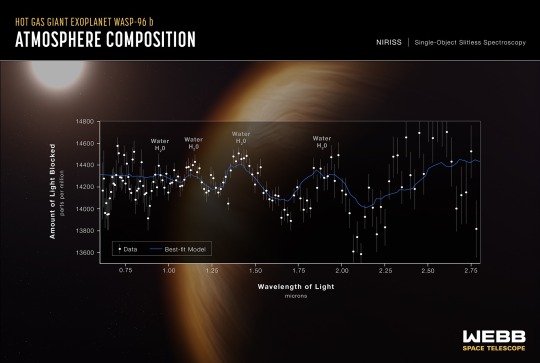
Webb didn’t observe the atmosphere of a giant, Jupiter-sized planet orbiting its star in THREE DAYS over 1000 light years away, just for everyone to ignore it. just because it isn’t a pretty picture doesn’t mean it isn’t an astounding feat of science and technology.
#like. you do realize we know the atmospheric composition of a planet that is OVER 1000 LIGHT YEARS AWAY#that is just ASTOUNDING#wasp-96b#exoplanets#jwst#james webb space telescope#astronomy#james webb#space
263 notes
·
View notes
Text
James Webb Uzay Teleskobundan İlk Görüntüler

James Webb Uzay Teleskobundan İlk Görüntüler Geldi
Geçtiğimiz aylarda James Webb Uzay Teleskobunun ne olduğundan ve amacından bahsetmiş, Haziran ayında bize göndereceği görüntüleri görmek içinde sabırsız bir bekleyişte olduğumuzu daha doğrusu tüm dünyadaki insanların sabırsız bir bekleyişte olduğunu söylemiştik. Geçtiğimiz günlerde ise Uzay Teleskobu yörüngesine oturtuldu ve gerekli ayarlamalar yapılarak James Webb Uzay Teleskobundan ilk görüntüler dünyamıza geldi.
Her fotoğrafı ayrı ayrı inceleyecek ve bu görüntülerdeki detayları sizinle paylaşacağız. Ama önce kısa ve hatırlatıcı olarak bir kez daha bu teleskobun ayrıntılarından bahsetmekte fayda var.
2007 yılında projenin bitirilmesi beklenirken teleskop, 25 Aralık 2021 tarihinde uzaya fırlatılarak dünyamızdan oldukça uzakta L2 yörüngesine doğru yolculuğa çıktı. Projenin bu kadar uzamasının nedeni ilk defa bu denli büyük bir projenin uzaya fırlatılacak olması. +10 milyar dolardan fazla miktardaki mali kaynağın ayrılması projenin herhangi bir aksaklıkta veya bir meteor çarpmasında bozulmasını önlemek amacıyla tekrar tekrar denemeler yapılarak teleskobun çalışamaz hale gelmesinin önüne geçmekti.
James Webb Uzay Teleskobu hakkında daha detaylı bilgi almak için tıklayınız.
Şansa bakın ki yörüngesine oturur oturmaz bir meteor James Webb Uzay Teleskobuna çarptı bile. Fakat 25 yıllık çalışmayla birlikte zaten böyle bir şeyin olma olasılığı hesaplanmış ve buna karşı ciddi ve pek çok önlem alınmıştı. Teleskop bu çarpmadan hiçbir hasar almadan işlevine devam etti.
Webb Uzay Teleskobunun Yörüngesi
Yörüngesinden bahsedecek olursak dünyadan oldukça uzakta 1 milyon 500 bin kilometre ötedeki L2 yörüngesi seçildi. Bunun temelde 2 nedeni var, Güneşten ve Dünyamızdan gelen ışığın James Webb Uzay Teleskobunun yakalayacağı görüntülere zarar vermemesinin istenmesi.
Bir diğer nedeni ise L2 yörüngesinin diğer yörüngelere nazaran daha az meteor ve asteroid içermesi. Oldukça farklı bir yörünge izleyen James Webb Uzay Teleskobu hem dikeyde dairseler olarak bir yörünge izliyor hem de L2 yörüngesinde ilerliyor. Görselde bunu daha net olarak görebilirsiniz.

James Webb Uzay Teleskobunun Yörüngesi
6 aylık bir ön hazırlık sürecinin ardından bilim adamlarınca belirlenen 5 ayrı noktaya odaklanan James Webb Uzay Teleskobu 5 ayrı görüntüyü dünyamıza gönderdi. Görüntüler NASA’nın 12 Temmuz tarihinde yaptığı canlı yayın ile tüm dünyaya gösterildi.
Bu 5 ayrı nokta 10 yılı aşkındır bilim adamlarınca yapılan önermeler ile belirlendi. Her bilim adamı evrenin gözlemek istediği noktasını ve önemini detaylı olarak NASA’ya iletti ve bu noktalar önem sırasına göre kabul edildi. 70 ayrı görevi hazır olan James Webb Uzay Teleskobu ilk 5 görevini oldukça başarılı bir şekilde tamamladı.
Görüntülere geçmeden önce James Webb Uzay Teleskobundan önce görev yapmakta olan, hala işlevini yitirmemiş Hubble Uzay Teleskobu hakkında detaylı bilgi almak için tıklayınız.
SMACS 0723
İlk görüntü 11 Temmuz günü, Başkan Joe Biden ile yapılan bir toplantı sırasına gösterildi.
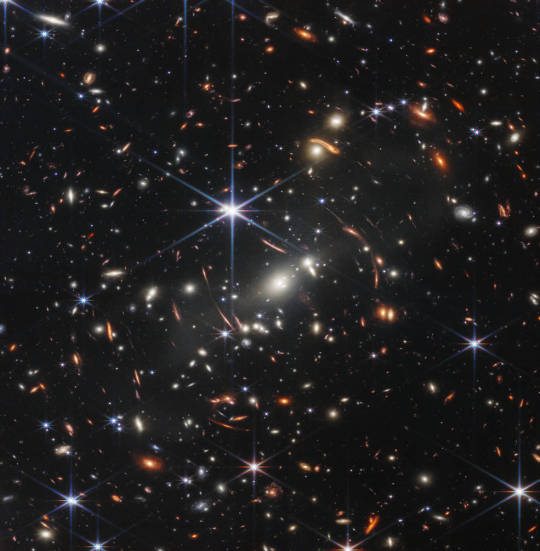
SMACS 0723'nin Webb Tarafından Çekilen Görüntüsü
Genç evrenin bugüne kadarki en detaylı görüntüsü SMACS 0723 adlı galaksi kümesine bakılarak görüntülendi. Kızılötesi teknolojisi sayesinde çekilen bu fotoğraf evrenin erken evresine dair pek çok detayı içeriyor. Bu galaksilerden gelen ışığın bize ulaşması neredeyse milyarlarca yıl sürdü.
Dünyamızdan 4.6 milyar ışık yılı uzaklıktaki SMACS 0723 adlı bu galaksi kümesinde oldukça parlak g��rünen cisimler yıldız, toplu ve daha sönük olanlar ise galaksileri temsil ediyor. Kırmızı renkteki galaksiler ise daha eski galaksilerdir, kırmızı görünmesinin sebebini herkes duymuştur “red shift” yani kırmızıya kayma. Bir galaksi bizden ne kadar uzaktaysa o kadar kırmızı renge kayar ve gözle görülemez bir hale gelir. Bu yüzden kızılötesi teknolojisini kullanarak bunları görebiliyoruz. Bu görseldeki bize en uzak galaksi ise 13.1 milyar ışık yılı uzaklıkta.

Webb Tarafından Çekilen Erken Evrenin Görüntüsü(SMACS 0723)
James Webb Uzay Teleskobunun amacından ve ne işe yaradığından bahsederken sıkça evrenin ilk safhalarını görmemize olanak sağlayacak olmasından bahsetmiştik. Bu fotoğraf bunun için çok büyük bir umut ışığı yakıyor. Genç evreni gözlemleyebiliyor ve görebiliyoruz.
13.1 MİLYON IŞIK YILI UZAKLIKTA GALAKSİYİ GÖREBİLİYORUZ.
Görüntüde görebileceğiniz bir diğer detay ise bazı kırmızı galaksilerin sanki sündürülmüş bir taraflarından tutup uzatılmış gibi görünmesi. Bunun nedeni ise bu galaksilerin eski ve yaşlı olmasından ve onların önündeki daha genç galaksilerin, eski galaksilerin ışığının bize gelirken kütle çekim kuvveti yüzünden kırılması ve bozulmasıdır. Yani görüntüde herhangi fiziki bir oynama yok.
James Webb Uzay Teleskobu bu görüntüyü çekebilmek için tam tamına 12 saat odaklanması gerekti. Hubble Uzay Teleskobun ise bu görüntüyü yakalayabilmesi için neredeyse 2 haftalık bir zaman dilimi gerekiyor.
Aşağıdaki fotoğrafta Hubble ve James Webb Uzay teleskobu tarafından çekilen SMACS 0723 galaksi kümesinin fotoğrafını görebilirsiniz. Aradaki farkı anlamak güç değil.

Sol taraftaki Hubble / Sağ taraftaki Webb Uzay Teleskobu(SMACS 0723)
Carina Nebulası

Webb Teleskobu Tarafından Çekilen Carina Nebulası
Bir sonraki görevi ise Carina Nebulası veya Carina Bulutsusu. Bu görüntü pek çok bilim insanının gözyaşlarını tutamamasına neden olmuş. Görmekte olduğunuz bir görüntü uzayın doğumevi olarak da geçiyor. 5 görsel arasındaki en heyecan verici ve en detaylı veriler kuşkusuz bu görselde barınmakta.
Üst tarafta yeni doğmuş bebek ve genç yıldızları görüyoruz. Bunlar daha çok genç ve çok sıcak yeni yeni bir yıldıza dönüştüler. Alt tarafta gaz bulutunun içerisinde doğacak olan diğer yıldızlar gelecek milyar yıllar içerisinde bir yıldıza dönüşecek. Gaz bulutunun içerisinde yıldızı oluşturacak temel elementler giderek etkileşime girecek ve ortaya yeni yıldızlar doğacak.
Aynı görüntüde hem yeni doğmuş yıldız ve galaksileri hem de yeni doğacak olan yıldız ve galaksileri görmek tüyleri ürpertiyor. Belki de yeni doğan galaksilerin içerisinde bir canlı yaşam mevcut veya yeni doğacak henüz doğmamış galaksilerin içerisindeki bir gezegende canlı yaşam mevcut olacak…
Stephan Beşlisi
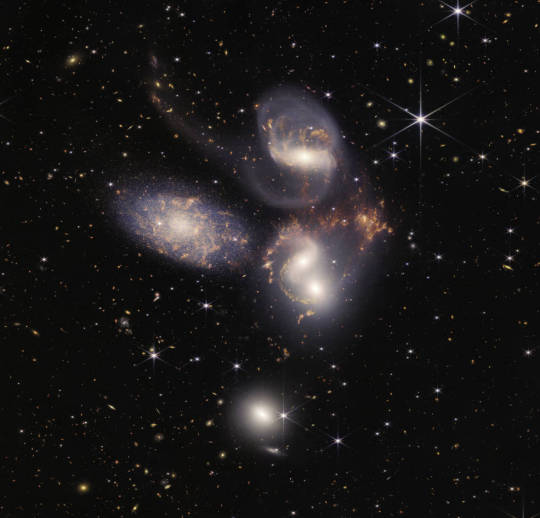
Stephan Beşlisi
Bir diğer görev ise Stephan Beşlisi. Bunu seçmelerinin nedeni burada bulunan galaksilerin birbirlerinin çok yakınında olması hatta 2 galaksinin birbirleri ile çarpışması. Etraftaki gaz ve toz bulutunun görebilmek mümkün bu yeni galaksilerin ve yıldızların doğumuna işaret ediyor.
Fotoğrafı daha önce yine Hubble Tarafından çekildi, ve burada 5 galaksinin bulunduğunu biliyorduk fakat James Webb Uzay Teleskobu bize bundan çok daha fazlasını söylemeyi başardı. Fotoğraftaki gaz ve toz bulutunun kimyasal yapısını da biliyoruz artık.
Aşağıdaki fotoğrafta Hubble ve James Webb Uzay teleskobu tarafından çekilen Stephen Beşlisinin fotoğrafını görebilirsiniz.

Sol taraftaki Hubble / Sağ taraftaki Webb Uzay Teleskobu(Stephen Beşlisi)
Southern Ring Nebulası

Southern Ring Nebulası
Bir diğer görev ise Southern Ring Nebulası yani Güney Halka Bulutsusu. Bu görüntüde oldukça güzel, ölmekte bir yıldızın adeta son nefesini verikenki halini görüyoruz. Yıldız öldüğü yani patladığı zaman etrafa saçtığı partiküllerin oluşturduğu bulutsu dalgayı görebiliyoruz.
Aşağıdaki fotoğrafta Hubble ve James Webb Uzay teleskobu tarafından çekilen Güney Halka Bulutsusunun fotoğrafını görebilirsiniz.
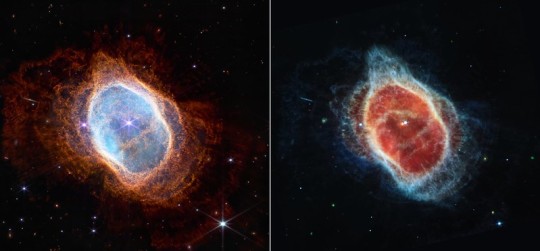
Sol Taraf Webb/ Sağ Taraf Hubble (Southern Ring Nebulası)
Wasp-96 b Öte Gezegeni

Wasp-96 b Öte Gezegeni Veri Grafiği
Son olarak bir öte gezegeni hedef alan James Webb Uzay Teleskobu WASP-96 b gezegenini yakın olarak görüntülemeyi başardı. Aslında görebileceğimiz şey bir görüntü değil bir veri setinin grafiğe işlenmiş hali. Bu gezegen güneşimiz benzeri bir yıldızın etrafında 1 tam turunu yaklaşık 3,5 günde tamamlıyor. Yani bizim 1 yılımız orada 3,5 güne eşit.
Dünyadan yaklaşık 150 bin ışık yılı uzaklıktaki sıcak ve çeşitli gazların çevrelediği bu öte gezegende James Webb Uzay Teleskobu buradaki su moleküllerinin varlığını tespit etti.
Sadece 1 haftalık bir sürede bize bu denli yüksek çözünürlükte görseller sunan James Webb Uzay Teleskobu ve biz dünyalılar için sadece bu bir başlangıç. 10 ila 15 yıllık görev süreci bulunan Teleskop herhangi bir aksilik yaşanmadığı sürece önümüzdeki günlerde bilim adamlarınca seçilen diğer noktalara odaklanarak bize pek çok farklı yerleri gösterebilecek.
Evrenin çok genç olduğu zamanlara +13 milyar ışık yılı uzaklıklardaki galaksileri ve yıldızları gözlemlemek artık mümkün. James Webb Uzay Teleskobu bununla da yetinmeyip gözlemlediği gezegenleri hangi moleküllerden oluştuğuna dair verileri de bize aktarmaya çalışacak.
NASA’nın sloganı ile sözü şimdilik bitirelim öyleyse.
GO WEBB
Kaynak: https://bilimuzay.com/james-webb-uzay-teleskobundan-ilk-goruntuler/
Read the full article
#carinanebulası#jameswebbuzayteleskobu#smacs0723#southernringnebulası#stephenbeşlisi#wasp-96b#webbuzayteleskobu
0 notes
Text
NASA'nın James Webb Teleskopu Uzak Gezegende Su Tespit Etti
NASA’nın James Webb Teleskopu Uzak Gezegende Su Tespit Etti
NASA’nın James Webb Teleskopu Uzak Gezegende Su Tespit Etti
NASA’nın James Webb Uzay Teleskobu, Güneş benzeri uzak bir yıldızın yörüngesinde dönen sıcak, kabarık gaz devi bir gezegeni çevreleyen atmosferde, bulutların ve pusların kanıtlarıyla birlikte suyun belirgin imzasını yakaladı.Bu James Webb Teleskobu daha önce de bizlere evrenin “en derin” fotoğrafını bizlere göstermişti.
NASA’nın James…

View On WordPress
#bilim uzay nasa nasa uzay#fizik#gezegen#ışık yılı#James Webb Teleskopu#nasa#NASA&039;nın#NASA&039;nın James Webb Teleskopu Uzak Gezegende Su Tespit Etti#NIRISS#ötegezegen#Uzak Gezegende Su Tespit Etti#WASP-96b#Yakın Kızılötesi Görüntüleyici#Yakın Kızılötesi Görüntüleyici ve Yarıksız Spektrografı (NIRISS)#Yarıksız Spektrografı (NIRISS)
0 notes
Text
James Webb Telescope: Alleged presence of water in the atmosphere of the Exoplanet Wasp-96 b
James Webb Telescope: Alleged presence of water in the atmosphere of the Exoplanet Wasp-96 b
Author: Hindemburg Melao Jr.
Reviewer: Scott Douglas Jacobsen
Numbering: Issue 30.B, Idea: Outliers & Outsiders (25)
Place of Publication: Langley, British Columbia, Canada
Title: In-Sight: Independent Interview-Based Journal
Web Domain: http://www.in-sightjournal.com
Individual Publication Date: July 15, 2022
Issue Publication Date: September 1, 2022
Name of Publisher: In-Sight…
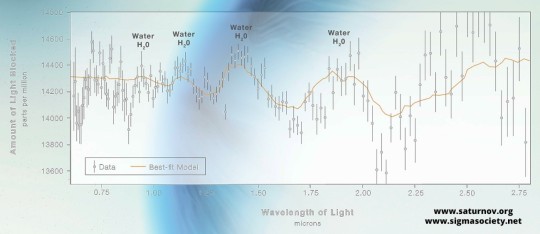
View On WordPress
0 notes
Link
#toronto üniversitesi#james webb teleskobu#sky#uzay#toronto university#karina bulutsusu#wasp 96b#jwst#news#bloomedianet#haber#haberler#müzikal#musical#nasa#uzay teleskobu#teleskop#jameswebuzayteleskobu
0 notes
Text
Exoplanet Heating

WASP-96B is a tidally-locked exoplanet between the size of Saturn and Jupiter. This hot, massive planet lies close to its star, orbiting in less than three-and-a-half Earth days. (Image and research credit: J. Skinner et al.; via APS Physics)
Read the full article
#atmospheric science#exoplanets#fluid dynamics#numerical simulation#physics#planetary science#science#turbulence#vortices
159 notes
·
View notes
Text
WHY IS JWST SO SPECIAL??
Blog# 213
Wednesday, July 27th, 2022
Welcome back,
On 12 July, the first set of full-resolution science images from the James Webb Space Telescope (JWST) was released. This set included astonishingly sharp pictures of the Carina Nebula, the Eight-Burst Nebula, a group of galaxies called Stephan’s Quintet and a galaxy cluster stretching the light of the objects behind it, as well as an analysis of the composition of an exoplanet named WASP-96b.
Here’s everything you need to know about the telescope that took these pictures and what it may be able to reveal next.
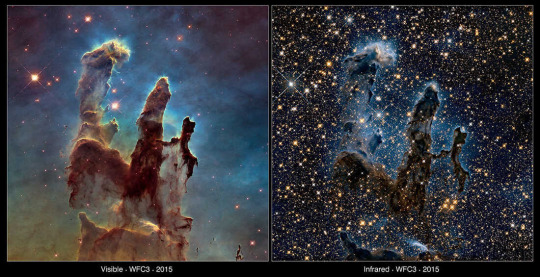
What is so special about these images? Didn’t we have the Hubble Space Telescope before JWST?
We did and do have Hubble, which produces so many gorgeous images of space. But JWST is way bigger, so its pictures are more detailed. It also observes in different wavelengths than Hubble, which allows it to see things – particularly super distant things – that Hubble can’t.
How close to the edge of the observable universe will JWST be able to see? I’ve seen 13.5 billion light years quoted – that seems very close to the age of the universe at about 13.8 billion years.
JWST should be able to see between 100 and 250 million years after the big bang! But while that is up to about 13.7 billion years ago, it’s not 13.7 billion light years away – it is much further than that, because of the expansion of the universe.

Will JWST study supermassive black holes? Can it produce an image similar to the one from the Event Horizon Telescope?
JWST can’t make an image of a supermassive black hole like the Event Horizon Telescope did – that’s a different kind of telescope – but it will study them. In fact, the picture of Stephan’s Quintet that was just released is providing some interesting information on one already.
Is it possible for gravitational lensing [like that seen in JWST’s first deep-field image] to be strong enough to see yourself? Like, light does a U-turn?
Yes! Black holes can have a feature called a photon sphere, where gravity’s pull is so strong that light orbits the black hole. So if you aim a light just outside the photon sphere you could, in theory, see that light come around the other side of the black hole.

If JWST can see 13.5 billion years back, could we one day make a telescope that can “see” further than the beginning of time?
I wish! Unfortunately, there’s a fundamental limit to how far back we can see, because up until a little less than 380,000 years after the big bang, the universe was completely filled with hot plasma and was therefore opaque.
Can we see further back than 380,000 years after the big bang with gravitational waves detected by the Laser Interferometer Gravitational-Wave Observatory (LIGO) or the Laser Interferometer Space Antenna (LISA)?
Love this question! Unfortunately, the answer is no, because gravitational waves come from the motion of masses, and there just weren’t any structures big enough to create measurable gravitational waves until about 100 million years after the big bang.

With the data and imagery collected, is it possible (or even probable) that scientists will revise the currently accepted age of the universe to be much much older than a mere 13.7 billion years?
It is possible that the data from JWST will cause us to revise the age of the universe based on new measurements of its expansion, but if so, it will probably go down rather than up.
Was there anything unexpected about the spectra of the galaxy and exoplanet obtained so far?
I don’t think there was anything particularly shocking in the data that’s come down so far. The images are all of systems that are already very well studied, but we just have far more detail now than ever before. So, we are seeing new things, but I don’t think those are very unexpected.

Why did the JWST crew choose WASP-96b as the first exoplanet to analyse the composition of? What was special about it?
What’s special about WASP-96b is that it isn’t cloudy – the new spectrum shows some evidence of clouds and haze, but not much. That’s good because it allows the starlight to shine right through the atmosphere and for us to analyse it without being blocked by lots of clouds.
How will astronomers decide what to take a picture of [with JWST] next?
The first year of science has actually already been planned out. Researchers made more than 1000 proposals for what to observe, and they were selected by panels of scientists.
Originally published on www.newscientist.com
COMING UP!!
(Saturday, July 30th, 2022)
“WHAT IS INSIDE THE BLACK HOLE??”
#astrophotography#astrophysics#Astronomy#spacecraft#spaceX#outer space#space#universe#alternate universe#white universe#Parallel Universe#astronomy#parallel universe#astronomylover
50 notes
·
View notes
Photo
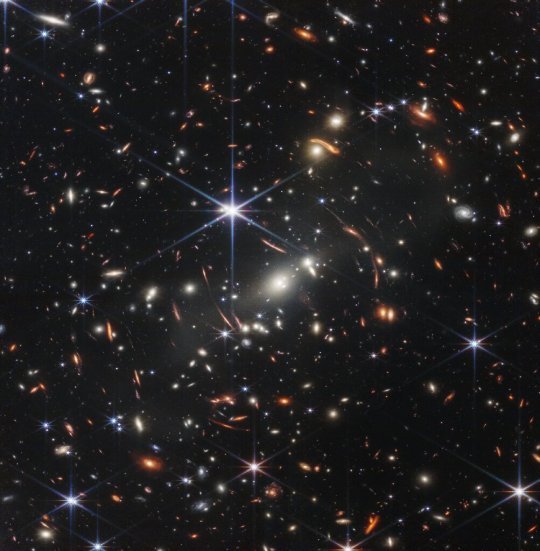
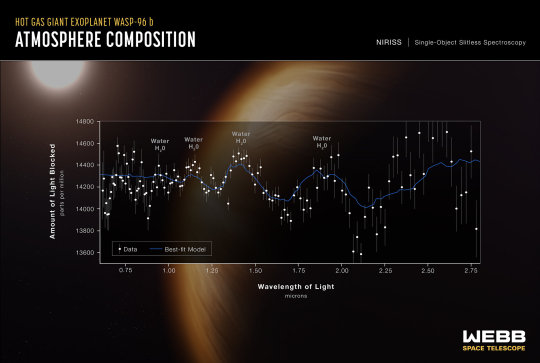
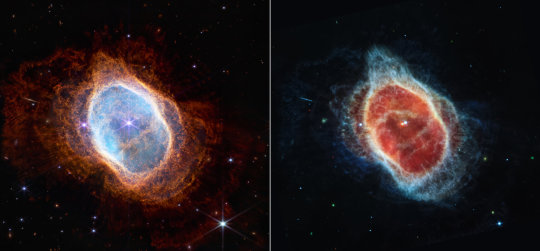
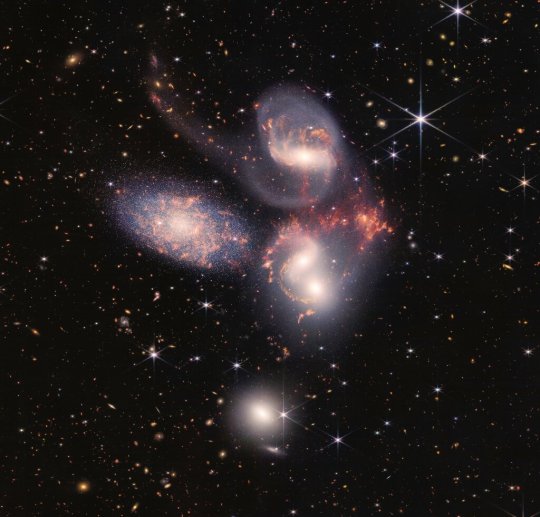
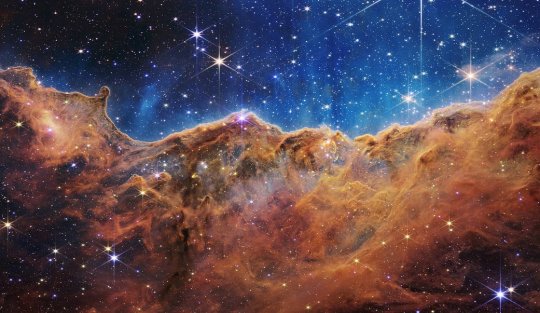
NASA Reveals Webb Telescope’s First Images of Unseen Universe The images include some taken by the telescope’s Mid-Infrared Instrument, which the Jet Propulsion Laboratory manages for NASA. The dawn of a new era in astronomy is here as the world gets its first look at the full capabilities of NASA’s James Webb Space Telescope, a partnership with ESA (European Space Agency) and CSA (Canadian Space Agency). “Today, we present humanity with a groundbreaking new view of the cosmos from the James Webb Space Telescope – a view the world has never seen before,” said NASA Administrator Bill Nelson. “These images, including the deepest infrared view of our universe that has ever been taken, show us how Webb will help to uncover the answers to questions we don’t even yet know to ask; questions that will help us better understand our universe and humanity’s place within it. “The Webb team’s incredible success is a reflection of what NASA does best. We take dreams and turn them into reality for the benefit of humanity. I can’t wait to see the discoveries that we uncover – the team is just getting started!” NASA explores the unknown in space for the benefit of all, and Webb’s first observations tell the story of the hidden universe through every phase of cosmic history – from neighboring planets outside our solar system, known as exoplanets, to the most distant observable galaxies in the early universe. “This is a singular and historic moment,” said Thomas Zurbuchen, associate administrator for NASA’s Science Mission Directorate. “It took decades of drive and perseverance to get us here, and I am immensely proud of the Webb team. These first images show us how much we can accomplish when we come together behind a shared goal, to solve the cosmic mysteries that connect us all. It’s a stunning glimpse of the insights yet to come.” “We are elated to celebrate this extraordinary day with the world,” said Greg Robinson, Webb program director at NASA Headquarters. “The beautiful diversity and incredible detail of the Webb telescope’s images and data will have a profound impact on our understanding of the universe and inspire us to dream big.” Webb’s first observations were selected by a group of representatives from NASA, ESA, CSA, and the Space Telescope Science Institute. They reveal the capabilities of all four of Webb’s state-of-the-art scientific instruments: SMACS 0723: Webb has delivered the deepest and sharpest infrared image of the distant universe so far – and in only 12.5 hours. For a person standing on Earth looking up, the field of view for this new image, a color composite of multiple exposures each about two hours long, is approximately the size of a grain of sand held at arm’s length. This deep field uses a lensing galaxy cluster to find some of the most distant galaxies ever detected. This image only scratches the surface of Webb’s capabilities in studying deep fields and tracing galaxies back to the beginning of cosmic time. WASP-96b (spectrum): Webb’s detailed observation of this hot, puffy planet outside our solar system reveals the clear signature of water, along with evidence of haze and clouds that previous studies of this planet did not detect. With Webb’s first detection of water in the atmosphere of an exoplanet, it will now set out to study hundreds of other systems to understand what other planetary atmospheres are made of. Southern Ring Nebula: This planetary nebula, an expanding cloud of gas that surrounds a dying star, is approximately 2,000 light-years away. Here, Webb’s powerful infrared eyes bring a second dying star into full view for the first time. From birth to death as a planetary nebula, Webb can explore the expelling shells of dust and gas of aging stars that may one day become a new star or planet. Stephan’s Quintet: Webb’s view of this compact group of galaxies, located in the constellation Pegasus, pierced through the shroud of dust surrounding the center of one galaxy to reveal the velocity and composition of the gas near its supermassive black hole. Now, scientists can get a rare look, in unprecedented detail, at how interacting galaxies are triggering star formation in each other and how the gas in these galaxies is being disturbed. Carina Nebula: Webb’s look at the “Cosmic Cliffs” in the Carina Nebula unveils the earliest, rapid phases of star formation that were previously hidden. Looking at this star-forming region in the southern constellation Carina, as well as others like it, Webb can see newly forming stars and study the gas and dust that made them. “Absolutely thrilling!” said John Mather, Webb senior project scientist at NASA’s Goddard Space Flight Center in Greenbelt, Maryland. “The equipment is working perfectly, and nature is full of surprising beauty. Congratulations and thanks to our worldwide teams that made it possible.” The release of Webb’s first images and spectra kicks off the beginning of Webb’s science operations, where astronomers around the world will have their chance to observe anything from objects within our solar system to the early universe using Webb’s four instruments. The James Webb Space Telescope launched Dec. 25, 2021, on an Ariane 5 rocket from Europe’s Spaceport in French Guiana, South America. After completing a complex deployment sequence in space, Webb underwent months of commissioning where its mirrors were aligned, and its instruments were calibrated to its space environment and prepared for science. The public can also view the new Webb images Tuesday on several digital screens in New York City’s Times Square and in London’s Piccadilly Circus beginning at 5:30 p.m. EDT and 10:30 p.m. GMT, respectively. The James Webb Space Telescope is the world's premier space science observatory. Webb will solve mysteries in our solar system, look beyond to distant worlds around other stars, and probe the mysterious structures and origins of our universe and our place in it. NASA Headquarters oversees the mission for the agency’s Science Mission Directorate. NASA’s Goddard Space Flight Center in Greenbelt, Maryland, manages Webb for the agency and oversees work on the mission performed by the Space Telescope Science Institute, Northrop Grumman, and other mission partners. In addition to Goddard, several NASA centers contributed to the project, including the agency’s Johnson Space Center in Houston, Jet Propulsion Laboratory in Southern California, Marshall Space Flight Center in Huntsville, Alabama, Ames Research Center in California’s Silicon Valley, and others.
20 notes
·
View notes
Photo

🚨BREAKING NEWS🚨 From @nasawebb - the list of images for #JWST!! ✨ SMACS 0723: cluster of galaxies 🟤 WASP-96b: exoplanet ✨ Southern Ring Nebula: A bubble-shaped nebula inside the constellation Vela ✨ Carina Nebula: a massive nebula inside the Carina constellation ✨ Stevens Quintet: five galaxies in the Pegasus constellation LET’S GOOOOOOOO #UnfoldTheUniverse https://www.instagram.com/p/CfwT9Czu4X7/?igshid=NGJjMDIxMWI=
18 notes
·
View notes
Text
James Webb Space Telescope First Images
12th July 2022 marks one of the most important days in the history of mankind. James Webb Space Telescope revealed its first images and I am at a loss for words. This blog is more than a way to share information but is a thanks to all the scientists, engineers, ad everyone else on the Webb team and a way to congratulate the entire scientific community and human kind as this marks a major step in unravelling the universe. Now I know that mine is an aerospace page but this one is going to have an astrophysics and astronomy side to it. If you want to read about the engineering behind the JWST the do read-( https://www.tumblr.com/blog/view/aerospace-anant/672455873494384640?source=share)
SMACS 0723

NASA’s James Webb Space Telescope has delivered the deepest and sharpest infrared image of the distant universe so far. Webb’s First Deep Field is galaxy cluster SMACS 0723, and it is teeming with thousands of galaxies – including the faintest objects ever observed in the infrared. Webb’s image is approximately the size of a grain of sand held at arm’s length, a tiny sliver of the vast universe. The combined mass of this galaxy cluster acts as a gravitational lens, magnifying more distant galaxies, including some seen when the universe was less than a billion years old. Einstein’s general theory of relativity describes how mass concentrations distort the space around them.
A gravitational lens can occur when a huge amount of matter, like a cluster of galaxies, creates a gravitational field that distorts and magnifies the light from distant galaxies that are behind it but in the same line of sight. The effect is like looking through a giant magnifying glass. It allows researchers to study the details of early galaxies too far away to be seen with current technology and telescopes.
It is a composite made from images at different wavelengths, totalling 12.5 hours using the NIRcam – achieving depths at infrared wavelengths beyond the Hubble Space Telescope’s deepest fields, which took weeks.
This image shows the galaxy cluster SMACS 0723 as it appeared 4.6 billion years ago, with many more galaxies in front of and behind the cluster. We are looking back in time to within a billion years after the big bang when viewing the youngest galaxies in this field. The light was stretched by the expansion of the universe to infrared wavelengths that Webb was designed to observe. Other features include the prominent arcs in this field. The powerful gravitational field of a galaxy cluster can bend the light rays from more distant galaxies behind it, just as a magnifying glass bends and warps images.
2. WASP-96b
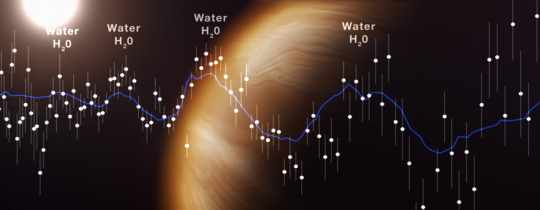
With a mass less than half that of Jupiter and a diameter 1.2 times greater, WASP-96 b is much puffier than any planet orbiting our Sun. And with a temperature greater than 1000°F, it is significantly hotter. WASP-96 b orbits extremely close to its Sun-like star, just one-ninth of the distance between Mercury and the Sun, completing one circuit every 3½ Earth-days. The combination of large size, short orbital period, puffy atmosphere, and lack of contaminating light from objects nearby in the sky makes WASP-96 b an ideal target for atmospheric observations. The observation, reveals the presence of specific gas molecules based on tiny decreases in the brightness of precise colours of light, is the most detailed of its kind to date, demonstrating Webb’s unprecedented ability to analyse atmospheres hundreds of light-years away. On June 21, Webb’s NIRISS measured light from the WASP-96 system for 6.4 hours as the planet moved across the star. The result is a light curve showing the overall dimming of starlight during the transit, and a transmission spectrum revealing the brightness change of individual wavelengths of infrared light between 0.6 and 2.8 microns.
While the light curve confirms properties of the planet that had already been determined from other observations – the existence, size, and orbit of the planet – the transmission spectrum reveals previously hidden details of the atmosphere: the unambiguous signature of water, indications of haze, and evidence of clouds that were thought not to exist based on prior observations.
3. STEPHENS QUINTET

Stephan’s Quintet, a visual grouping of five galaxies. This enormous mosaic is Webb’s largest image to date, covering about one-fifth of the Moon’s diameter. It contains over 150 million pixels and is constructed from almost 1,000 separate image files. With its powerful, infrared vision and extremely high spatial resolution, Webb shows never-before-seen details in this galaxy group. Sparkling clusters of millions of young stars and starburst regions of fresh star birth grace the image. Sweeping tails of gas, dust and stars are being pulled from several of the galaxies due to gravitational interactions. Most dramatically, Webb captures huge shock waves as one of the galaxies, NGC 7318B, smashes through the cluster. Tight groups like this may have been more common in the early universe when their superheated, infalling material may have fuelled very energetic black holes called quasars. Even today, the topmost galaxy in the group – NGC 7319 – harbours an active galactic universe, a supermassive black hole 24 million times the mass of the Sun. It is actively pulling in material and puts out light energy equivalent to 40 billion Suns. In NGC 7320, the leftmost and closest galaxy in the visual grouping, Webb was able to resolve individual stars and even the galaxy’s bright core. it will help scientists understand the rate at which supermassive black holes feed and grow. Webb also sees star-forming regions much more directly, and it is able to examine emission from the dust – a level of detail impossible to obtain until now.
4. SOUTHERN RING NEBULA

Two cameras aboard Webb captured the latest image of this planetary nebula, catalogued as NGC 3132, and known informally as the Southern Ring Nebula. It is approximately 2,500 light-years away. The dimmer star at the centre of this scene has been sending out rings of gas and dust for thousands of years in all directions, and NASA’s James Webb Space Telescope has revealed for the first time that this star is cloaked in dust. This observation shows the Southern Ring Nebula almost face-on, but if we could rotate it to view it edge-on, its three-dimensional shape would more clearly look like two bowls placed together at the bottom, opening away from one another with a large hole at the center.
Two stars, which are locked in a tight orbit, shape the local landscape. Webb's infrared images feature new details in this complex system. The stars – and their layers of light – are prominent in the image from Webb’s NIRCam on the left, while the image from Webb’s MIRI on the right shows for the first time that the second star is surrounded by dust. The brighter star is in an earlier stage of its stellar evolution and will probably eject its own planetary nebula in the future.
In the meantime, the brighter star influences the nebula’s appearance. As the pair continues to orbit one another, they “stir the pot” of gas and dust, causing asymmetrical patterns.
Each shell represents an episode where the fainter star lost some of its mass. The widest shells of gas toward the outer areas of the image were ejected earlier. Those closest to the star are the most recent. Tracing these ejections allows researchers to look into the history of the system.
As the star ejects shells of material, dust and molecules form within them – changing the landscape even as the star continues to expel material. This dust will eventually enrich the areas around it, expanding into what’s known as the interstellar medium. And since it’s very long-lived, the dust may end up traveling through space for billions of years and become incorporated into a new star or planet.
5. CARINA NEBULA

This landscape of “mountains” and “valleys” speckled with glittering stars is actually the edge of a nearby, young, star-forming region called NGC 3324 in the Carina Nebula. Captured in infrared light by NASA’s new James Webb Space Telescope, this image reveals for the first time previously invisible areas of star birth. Called the Cosmic Cliffs, Webb’s seemingly three-dimensional picture looks like craggy mountains on a moonlit evening. In reality, it is the edge of the giant, gaseous cavity within NGC 3324, and the tallest “peaks” in this image are about 7 light-years high. The cavernous area has been carved from the nebula by the intense ultraviolet radiation and stellar winds from extremely massive, hot, young stars located in the center of the bubble, above the area shown in this image.
The blistering, ultraviolet radiation from the young stars is sculpting the nebula’s wall by slowly eroding it away. Dramatic pillars tower above the glowing wall of gas, resisting this radiation. The “steam” that appears to rise from the celestial “mountains” is actually hot, ionized gas and hot dust streaming away from the nebula due to the relentless radiation. Because of Webb’s sensitivity to infrared light, it can peer through cosmic dust to see these objects. Protostellar jets, which emerge clearly in this image, shoot out from some of these young stars. The youngest sources appear as red dots in the dark, dusty region of the cloud. Objects in the earliest, rapid phases of star formation are difficult to capture, but Webb’s extreme sensitivity, spatial resolution, and imaging capability can chronicle these elusive events.
These observations of NGC 3324 will shed light on the process of star formation. Star birth propagates over time, triggered by the expansion of the eroding cavity. As the bright, ionized rim moves into the nebula, it slowly pushes into the gas and dust. If the rim encounters any unstable material, the increased pressure will trigger the material to collapse and form new stars.
BIBLIOGRAPHY:
1. https://www.nasa.gov/webbfirstimages
2. https://webbtelescope.org/contents/news-releases/2022/news-2022-031
3. https://webbtelescope.org/glossary.html#h3-CK-2572b869-1584-45c0-a18b-0c5ffcf32e57
4. https://esawebb.org/announcements/ann2207/
5. https://hubblesite.org/contents/articles/gravitational-lensing
#james webb first full colour image#physics#science#aerospace#space#tech#james webb space telescope#james webb 5 points on what new telescope aims to achieve james webb#james webb deepest sharpest view of universe#nasa#carina nebula#astronomy#webb#jwst#images#first images
13 notes
·
View notes
Text
Finally... The JWST's First Images Are Here And They Are... UGH! Mesmerising.

After 25+ years of designing, planning, building, launching, unfolding and testing, the first images by the James Webb Space Telescope have been released, and reveal the full promise and spectacular nature of what this mighty observatory can achieve.
The James Webb Space Telescope is a space telescope designed primarily to conduct infrared astronomy. (What is infrared astronomy? Keep reading) As the largest optical telescope in space, its greatly improved infrared resolution and sensitivity allows it to view objects too old, distant, or faint for the Hubble Space Telescope.
The huge 6.5-meter mirror, made up of 18 hexagonal small gold-plated mirrors, gathers a huge amount of light and provides a sharp view of the cosmos, so the images are clean and high-resolution, and the battery of filters means we can convert them into color images to please our eyes and inform our brains.
Okay now what is infrared astronomy right? Infrared astronomy is a sub-discipline of astronomy which specializes in the observation and analysis of astronomical objects using infrared radiation.
Now don't keep your eyes and brain waiting. Let's go!
____________________________________________________________________________
SMACS 0732
The first JWST Deep Field image shows SMACSJ0723.3-7327: a galaxy cluster, a collection of hundreds of galaxies orbiting their mutual center of gravity. It lies very roughly 4.5 billion light-years from Earth.
You might be thinking, what's exactly going on in this picture. The sharp objects with diffraction spikes are all stars in our own Milky Way galaxy, probably hundreds of thousands of light years away. But every fuzzy thing you see? Those are entire galaxies, all like billions of light years away. And there are thousands of them in this image.
Thousands.

Including the smallest, faintest objects ever observed. Webb's image is approximately the size of a grain of sand held at arm's length, a tiny silver of the vast universe.
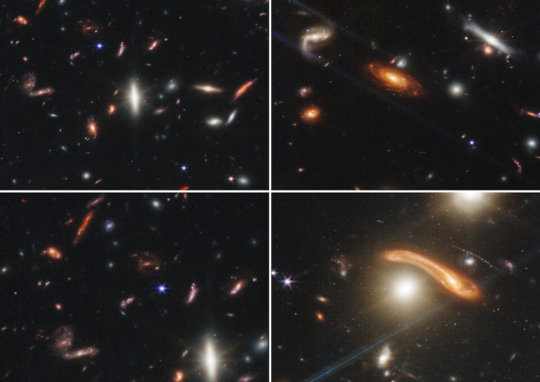
____________________________________________________________________________
WASP-96B
1,100 or so light-years from Earth is a Sun-like star, but is a very un-solar-system-like exoplanet orbiting it. That planet is WASP-96b, a hot jupiter with about the same size as our own Jupiter, but half the mass, and it orbits the star once every 3.4 days at a distance of only 7million kilometers!

____________________________________________________________________________
NGC3132, THE SOUTHERN RING NEBULA
NGC 3132 is a planetary nebula, the gas and dust ejected away from a star that was once much like the Sun but then ran out of fuel in its core and died. The central star expanded into a red giant, blew away thick layers of material, then exposed its hot core which then blew less dense but hotter and faster gas into that previously ejected stuff. This carved a huge expanding bubble into it.
The star in the center is actually two stars, a binary system. The second star is buried in so much material it's not visible in shorter wavelength. The binary motion may be what shaped the nebula, their orbits around each other sculpting the way the gas was ejected.
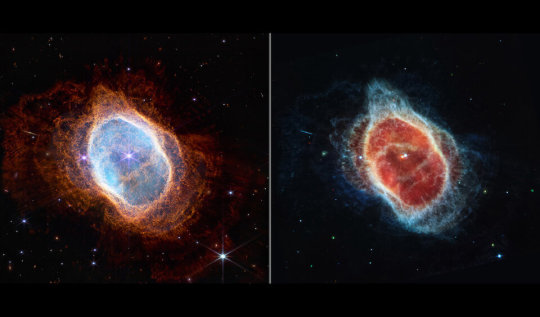
____________________________________________________________________________
STEPHEN'S QUINTET
300 million light-years from Earth is Stephen's Quintet, a small clutch of interacting galaxies... well, four of them are. The fifth, NGC 7320 (left) is actually a foreground galaxy coincidentally aligned with the more distant group.

The NIRCAM image shows cool gas and dust in the group, including some flung out NGC 7318 a and b (center), two galaxies deep in the process of colliding. The gravity of the two galaxies can send out streamers of material, called tidal tails, which then cools and forms stars.

The MIRI image shows something more: The center of NGC 7139 (top) is very bright, and that means we're seeing the tremendous light from a supermassive black hole, eagerly gobbling down gas and dust in the galaxy's core. Images like this (and spectra) can tell astronomers vast amounts about this process, like how massive the black hole is, how much material it's eating, what happens to that matter as it falls in, and how some of it is blasted away in long, thin beams of jets that can fly away from the black hole at speeds a decent fraction of the speed of light!
____________________________________________________________________________
CARINA NEBULA
In the southern constellation of Carina is a ridiculously huge, sprawling cloud of gas and dust called Carina Nebula, It's very roughly 7,000 light-years from Earth, and one of the Milky Way's most active star forming factories.

In this JWST NIRCAM (Near Infrared Camera) image you can see a very handful of very massive, luminous stars at the top. These blast out radiation and winds of subatomic particles that eat away at the gas and dust, evaporating them. This leaves behind a wall of material - that bright, scalloped horizontal line - with dense material below and less dense, hotter material above. It looks almost like a mountain ridge or, approximately, a cloudbank.

In the MIRI (Mid Infrared Image) we can see the effect of this: Dozens of stars are being born there, some blowing away their birth gas, others still deeply enshrouded in the materials that are forming them.
____________________________________________________________________________
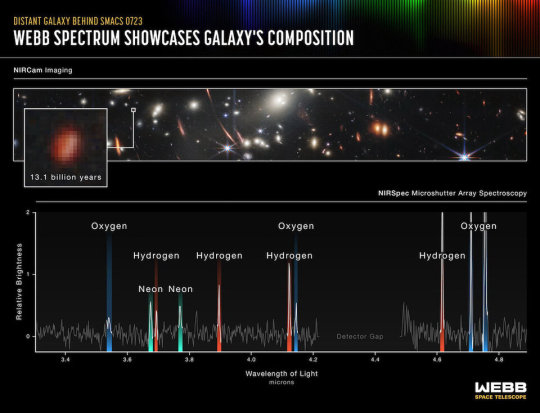
After seeing SMACS 0732 image we can think about how big the sky is compared to that grain of sand. This entire sky can fit something like 25 million such images in it. This image is a tiny, tiny fraction of the Universe, yet it shows wonders and delights by the thousands.
What will we see when JWST stares at one spot for as long, how many tens of thousands of distant galaxies will be revealed? How many hundreds of billions more await our investigation?
Once you grasp that, you'll glimpse why astronomers do what they do.
It's an immense Universe, and we want to understand all of it. With JWST we have taken a big step forward in doing just that.
6 notes
·
View notes
Note
hellooooo
can we hear some Neat Space Facts please???
yeah of course!!!
most stars we’ve observed orbit in a binary system - our sun is actually an outlier in this facet - so it’s hypothesized that the sun may have a “long lost twin” that was drifted out of the solar system during its formation
our solar system is neatly split up into terrestrial planets near the sun and gas giants farther out, and for a long time, scientists thought that this was the standard for solar systems. however, our solar system is a huge outlier! for example, WASP-96b, the exoplanet that webb just got atmospheric information for, is extremely close to its star and orbits it in 3 days.
before newton, (and even after) many scientists thought that there was some invisible force in spacetime called Ether that was like a flowing river of force causing the planets to orbit the way they did.
the north star, polaris, is actually a triple star system, with polaris Aa, b, and Ab orbiting each other
gravity is actually caused by the warping of spacetime. imagine it being like one of those funnel coin things, with a massive object at the center (stars, galaxies, black holes, etc) causing spacetime to bend, and for a smaller object like the coin to fall towards the center in an elliptical orbit. this is basically an extremely simplified version of the theory of general relativity.
also! if you want more space content (shameless self promo lol) ive made a space blog @aspaceinthecosmos so you can follow that if you want more space facts :)))
1 note
·
View note
Link
In the past two and a half years, two next-generation telescopes have been sent to space: NASA’s James Webb Space Telescope (JWST) and the ESA’s Euclid Observatory. Before the decade is over, they will be joined by NASA’s Nancy Grace Roman Space Telescope (RST), Spectro-Photometer for the History of the Universe, Epoch of Reionization, and Ices Explorer (SPHEREx), and the ESA’s PLAnetary Transits and Oscillations of stars (PLATO) and ARIEL telescopes. These observatories will rely on advanced optics and instruments to aid in the search and characterization of exoplanets with the ultimate goal of finding habitable planets. Along with still operational missions, these observatories will gather massive volumes of high-resolution spectroscopic data. Sorting through this data will require cutting-edge machine-learning techniques to look for indications of life and biological processes (aka. biosignatures). In a recent paper, a team of scientists from the Institute for Fundamental Theory at the University of Florida (UF-IFL) recommended that future surveys use machine learning to look for anomalies in the spectra, which could reveal unusual chemical signatures and unknown biosignatures. The study was conducted by a mix of physicists and machine learning experts, including Associate Professor Katia Matcheva, physics graduate student Roy T. Forestano, Professor Konstantin T. Matchev, and Ph.D. student Eyup B. Unlu. A preprint of their paper, “Searching for Novel Chemistry in Exoplanetary Atmospheres using Machine Learning for Anomaly Detection,” recently appeared online and is being reviewed for publication in the Astrophysical Journal. As they explained, the central premise of their paper is that what constitutes “life” remains an open question for scientists, and it would be advantageous to expand the scope of our search. Spectra from the WASP-96b’s atmosphere obtained by JWST. Credit: NASA/ESA/CSA/STScI First off, it is important to acknowledge how far the study of exoplanets has come in recent decades. The first confirmed detection did not take place until 1992, which consisted of two Super-Earths (Poltergeist and Phobitor) observed around a pulsar (PSR B1257+12, aka. Lich) located 2,300 light-years from Earth. While scientists firmly believed that most stars had their own system of planets, they had no incontrovertible proof before this discovery. And until the Kepler Space Telescope launched in 2009, exoplanet discoveries were being added at a rate of a few per year. Since then, a total of 5,496 exoplanets have been confirmed in 4,096 systems, with another 9,820 candidates awaiting confirmation. In recent years, the process has shifted from the process of discovery towards characterization, where improved instruments and methods have enabled astronomers to analyze exoplanet atmospheres directly to measure their potential habitability. As Prof. Matcheva explained to Universe Today via email: “The instruments are getting better and better: better spectral resolution, exceptional signal-to-noise level, wider wavelength coverage. In addition to JWST, which has returned some exceptional spectroscopic observations of several exoplanets, ESA is planning a dedicated exoplanet space telescope ARIEL that will observe 1000 planets. Analyzing this data will keep scientists busy for a long time.” According to Matcheva, the fields of exoplanet studies and astrobiology are incredibly fascinating because of the sheer potential involved. Currently, the field is largely concerned with constraining “habitability” through the targeted search for biosignatures: evidence of life and organic processes. Using Earth as a template, the only planet where we know life exists, the most highly-sought biosignatures include nitrogen gas (N2), oxygen gas (O2), carbon dioxide (CO2), methane (CH4), ammonia (NH?), and water (H2O). This constitutes the “low-hanging fruit approach,” where scientists are looking for life that conforms to terrestrial standards. This is not an accident, nor is it a lazy approach. It’s simply because it is exceedingly difficult to search for signs of life that we are completely unfamiliar with. But this also presents an opportunity to contemplate the possibilities and expand the range of what we know. “Do we know what to search for?” Matcheva added. “Do we know where to search? Would we recognize it if we saw it? The exoplanet science community always works with these questions in mind.” For their study, Matcheva and her colleagues investigated how machine learning could be trained to look for “anomalies” in transit spectra. This refers to light curves obtained by observing distant stars for periodic dips in luminosity, which could indicate the presence of a planet passing in front of the star relative to the observer. This is known as Transit Spectroscopy (or the Transit Method), which remains the most effective and widely-used method for detecting exoplanets. In addition to detection, this method allows astronomers to occasionally observe light passing through the planet’s atmosphere. When measured with a spectrometer, these observations will reveal data on the atmosphere’s chemical composition, which could include telltale biosignatures! In the coming years, the combination of next-generation telescopes and machine learning (ML) will allow astronomers to more accurately determine the potential habitability of exoplanets. “We believe that ML methods in astrophysics can be a game changer in how we process data in terms of speed, volume, and methodology, said Matcheva. “And we see that across all fields of science.” For their purposes, Matcheva and her team used two popular anomaly-detection machine learning methods – Local Outlier Factor (LOF) and One-Class Support Vector Machine (OCSVM) to analyze a large public database of synthetic spectra. This database was developed by the ESA ARIEL science team in anticipation of the mission (scheduled to launch in 2029) and contains more than 100,000 computer-generated spectra signals of exoplanets. The team also used Receiver Operating Characteristic (ROC) curves to quantify and compare the performance of the two ML techniques. The process and results, as Matcheva related, were both fascinating: “The spectra are calculated with current models, assuming that the atmosphere of each planet is a mixture of 5 different gasses in different proportions. As an experiment, we treated one of the absorbers (for example, H2O) as a ‘mystery’ absorber. We trained the ML algorithm on a subset of the data that is deficient in H2O and tested if it will correctly flag planets with water as anomalous.” “We repeated the experiment for four of the gasses. We used both LOF and OCSVM. Both methods did an outstanding job in finding the anomalous planets when no noise or very little noise (~10 ppm) is present, even for very small amounts of the ‘mystery’ gas. Unsurprisingly, the ML model starts making mistakes when the noise level increases too much.” A major objective for next-generation space telescopes will be the search for signs of life (biosignatures). Credit: NASA As Matcheva indicated, their paper demonstrated that LOF and OCSVM methods are very robust, even in the presence of signal noise. These results offer a taste of what could be possible in the near future, where literally thousands of exoplanets can be analyzed rapidly and systematically using ML methods to identify anomalous planets for follow-up investigations. These examinations will likely be very educational, given that inconsistencies between theoretical models and observations are often how the most exciting discoveries are made. “Although looking for biosignatures was not a primary goal of this paper, it is a very interesting outcome, and we are very excited about the potential of the method,” said Matcheva. “Looking for signatures of life in the Universe is more like looking for a needle in a haystack rather than for a smoking gun. It is actually even more challenging because we do not know what the needle looks like. The novelty detection methods are designed exactly for that: rare events [where] we do not know what they look, smell, or sound like.” As noted earlier, the search for extraterrestrial life – and indeed, the search for extraterrestrial intelligence (SETI) – can be summarized as searching for life “as we know it.” But if life is very rare in the Universe or very “exotic” in nature (meaning that it can arise from all sorts of chemicals and conditions), then it makes sense to cast a wider net. After all, if our frame of reference is an impediment to our astrobiology efforts (one could certainly argue as much), expanding it could be the difference between finding evidence that we are not alone and leaving the question unanswered for another generation. Said Matcheva: “The astrobiology community has been working on a definition of “life” for a long time, but we have no idea what aliens really look like and how they would interact with their environments. We are biased by our human experience, and the current strategies are to search for life in the “habitable zone,” which by definition is human (or terrestrial life) friendly. So how do you search for something when you don’t know what it looks like? That is where the novelty detection machine learning techniques come in – they can flag data points that are inconsistent with the training data, i.e., do not agree with the current theoretical models. So indeed, in that sense, our method is searching for life “as we don’t know it”. As Isaac Asimov famously said, “The most exciting phrase to hear in science, the one that heralds new discoveries, is not ‘Eureka!’ but ‘That’s funny.'” Further Reading: arXiv The post The Most Compelling Places to Search for Life Will Look Like “Anomalies” appeared first on Universe Today.
0 notes
Video
youtube
【本格始動1周年】壮大な眺め!ジェイムズウェッブ望遠鏡が太陽に似た星の驚くべきクローズアップで記念日絶景!!
【2023年7月12日】本格始動1周年記念公開しました!
■速報編:へびつかい座ρ(ロー)星(4:55)
https://youtu.be/rz317SV-xcA
📝目次📝
-------------------------------------------------
0:00 へびつかい座ρ星
1:26 近赤外線NIRCam画像
2:07 恒星S1
2:46 恒星円盤
3:15 1周年記念総括
4:23 2年目以降の抱負
2023年7月12日、太陽に似た星がうごめく驚くべきクローズアップで公開。
打ち上げは12月ですが、大統領のもとウェッブ宇宙望遠鏡の初成果が
披露されたのが、ちょうど1年前の7月12日だった。
その最初の科学成果と知見をもたらした記念すべき1周年に選ばれた天体が、
多くの星がまさに誕生している領域「星形成領域」にある「へびつかい座ρ(ロー)星」。
ここは太陽系から、最も近い距離にある星形成領域でもあります。
【2021年12月25日 午後9:20(日本時間)】ジェイムズウェッブ宇宙望遠鏡打ち上げ成功!
【2022年7月12日】初のフルカラー画像公開
5つの最初のフルカラー画像および分光観測データが公開された。
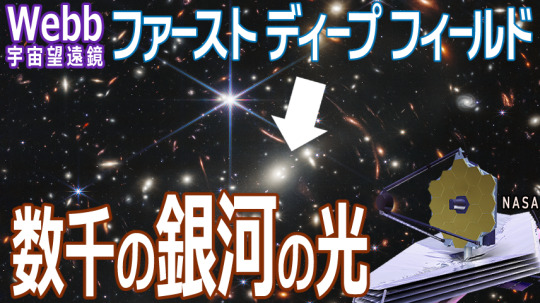
■宇宙の銀河団 SMACS 0723:初公開深宇宙
https://youtu.be/EWD-J8nNGo0

■カリーナ星雲:7600光年かなたに輝く「宇宙の断崖」
https://youtu.be/g9LFmMC3TGc

■ステファンの五つ子銀河
・ビジュアル編
https://youtu.be/v2xckUzte5U
・超大質量ブラックホールデータ編
https://youtu.be/j7zBylsMJj0
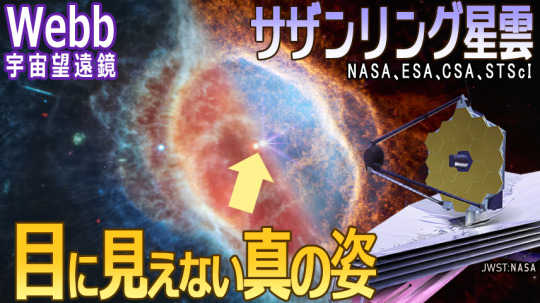
■サザンリング星雲:目には見えない赤外線の真の姿。
https://youtu.be/v0iN5hG-auw
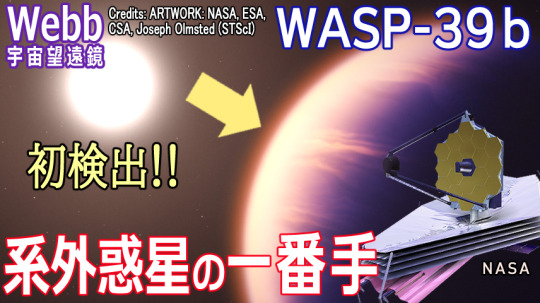
■系外惑星 wasp-96b:人類史上最も詳細な赤外線外惑星透過スペクトルデータ
https://youtu.be/BAuXSH1J6-0
初公開された5つの天体の特集動画もありますので、
この機会にぜひ!お立ち寄りください。
世界が注目する天体とはどんな天体なのか?
今後も追っかけをしていきたいと思います。
動画制作がとてもじゃないけど追いついていませんが、
気長に待ちつつ、乞うご期待!!
🎬店長の気になるグッズ・映画🎬
-------------------------------------------------
▼ジェイムズウェッブ宇宙望遠鏡のLEGO
https://ideas.lego.com/projects/e8102826-7585-4695-a6dd-b72450281feb
▼NASAジェイムズウェッブ宇宙望遠鏡JWST記章のロゴ Tシャツ
ブランド: NASA - Official
https://amzn.to/3JRfWBh
▼NASAジェイムズウェッブ宇宙望遠鏡JWST記章ミートボール Tシャツ
ブランド: NASA - Official
https://amzn.to/3pMd6H6
▼Webb 宇宙望遠鏡 グラデーション イエローミラー 星雲 JWST トレーナー
ブランド: The Universe of The Webb Space Telescope JWST
https://amzn.to/3pIKv5B
▼アルバム JWST (1曲 4分)MP3 ダウンロード Music Unlimited
https://amzn.to/44L6c3R
#ジェイムズウェッブ宇宙望遠鏡 #へびつかい座 #NASA #銀河 #星雲
0 notes
Text
How JWST could find signs of alien life in exoplanet atmospheres
https://sciencespies.com/space/how-jwst-could-find-signs-of-alien-life-in-exoplanet-atmospheres/
How JWST could find signs of alien life in exoplanet atmospheres
The James Webb Space Telescope can peer into alien skies like never before. With six potentially habitable planets within its sights, astronomers are entering a new era in the search for biology beyond our solar system
Space
9 November 2022
By Stuart Clark
graham carter
WHEN the first observations from the James Webb Space Telescope (JWST) were made public in July 2022, the images of deep space were so breathtakingly beautiful that it was easy to overlook the dowdy-looking graph released alongside them. The world was agog at the majestic panoramas of clouds of gas and dust from which stars are born, and the shining spiral shapes of ludicrously distant galaxies. Yet for many astronomers, the graph, a simple curving line, was just as jaw-dropping. It heralded a new era in the search for alien life.
Showing the unambiguous detection of water vapour in the atmosphere of an exoplanet called WASP 96b, it was the first proof that this powerful telescope would be able to deliver what many had doubted, namely, precise details of the contents of atmospheres on worlds beyond our solar system. Just as the beauty of some of those deep-field images captured the imaginations of the public, the quality of this unprecedented graph electrified astronomers. Suddenly, it was clear we really can peer into alien skies like never before. Finally, we have a fighting chance of spotting the subtle signals that would prove life exists elsewhere – not that it will be easy.
Now, astronomers are plotting their next moves. Having whittled down the most promising planets, they are lining up observing time with JWST to probe their atmospheres, thinking again about what signs of life we should be looking for – and sizing up the prospects of success. “I feel like we’re at the beginning of a really exciting journey,” says …
#Space
0 notes